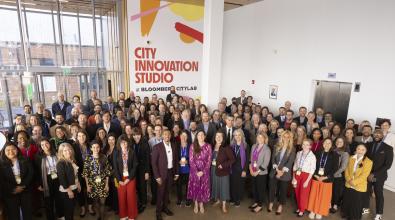Reaching ‘functional zero’ homelessness; here’s how communities are getting there
Bloomberg Cities poses five questions for Rosanne Haggerty, whose Built for Zero movement is changing the ways cities are tackling homelessness.

At a moment when the homelessness crisis seems out of control, Rosanne Haggerty has a simple message for local leaders: You need to believe the problem is solvable in order to actually solve it.
Haggerty is president and chief executive officer of the nonprofit Community Solutions. Her Built for Zero movement is grounded in the push to achieve “functional zero” as a measurable milestone for key populations such as veterans, meaning that homelessness, when it occurs, is rare and brief. Already, 14 communities have achieved this goal for at least one population, and 44 have achieved measurable reductions in homelessness. Haggerty has also earned big support in her efforts, including a $100-million grant from the MacArthur Foundation to end homelessness in 75 communities across America.
Haggerty challenges governments to look at homelessness as an issue where timely data can supercharge collaborations among nonprofit, public, and private actors and lead to transformational results. But she says progress also requires that it be approached from a personal level. She understands the enormity of the problem but insists cities must know the people they want to help, by name.
Haggerty sat down with Bloomberg Cities to discuss her efforts, successes, viewpoints and what she sees as the next big opportunity in this important work.
In what ways are cities making progress—and how are they falling short—in their approaches at addressing homelessness?
If the goal is fewer people experiencing homelessness, and down to the standard of functional zero, that must be the collective measure. As opposed to the way we've historically thought of homelessness in terms of the amount of money we’re spending, or the number of housing units we’re going to build, or looking at the program outcomes that apply to assisting the homeless. That’s not going to change the trajectory of this issue.
What does change the trajectory—and what those communities that are succeeding and seeing reductions are doing—is treating homelessness almost like a public-health emergency or an emergency-management problem. These communities understand it as a collective-action problem. They’ve got all the agencies, institutions, and actors aligned toward a single goal of getting to functional zero homelessness. They’ve got their arms around the dynamics of the problem. They know in real time how many people are affected, who they are, and they are making decisions based on that live data.
Data is such a critical ingredient. In the 14 communities you say have functionally ended homelessness for a population, what are they doing in terms of data?
They’ve gotten all the key folks around the same table and begun to get from their data something that we have collectively understood as a necessary new normal: that you know everyone experiencing homelessness by name, in real time, and you have it in one place—your homeless management information system. It’s individual data that’s complete and accurate and timely to better enable each individual or household to be served.
But you also have the capacity to zoom up to that collective aggregate, so you can see whether what you’re doing as a community is working. Are you slowing down inflow? Are you speeding up housing placements? Communities that have gotten to functional zero already have that shared aim and have their data together in this new standard. It allows communities to put their resources in more impactful places.
Rockford, Ill., was the first community to get to functional zero veteran homelessness, and then to also get to a functional zero chronic homelessness. Getting to quality data was, in some ways, the tipping point because it forced folks to collaborate think about outreach in new ways.
Communities feel overwhelmed by homelessness but they really can’t tell you the dimensions of the problem. Are we talking about 1,000 people who’ve been homeless for 30 years or 500 people who just left their apartment last month because of the end of COVID assistance? Without knowing what’s going on, communities are at a loss to know all the pathways to solutions. That’s why the space of innovation around data and training the frontline staff and middle management in the in the use of data for problem solving is a powerful space.
Another innovation capability embedded in this approach is human-centered design. How can cities deploy that to address homelessness?
We have found human-centered design to be immensely powerful. Any community of any size could look at this issue and say, “Oh we don’t have enough housing, end of story. Until there’s enough housing, nothing can be done.” If you have human-centered design in your toolbox, you go to the people experiencing the problem and really understand it in new ways that upends your assumptions. You find out how people experiencing homelessness have so many very simple pragmatic insights into public-assistance programs. You learn about how the systems we have built around vulnerable people are often themselves the problem. It opens up a much wider array of solutions to people’s housing needs than the commonly imagined ones.
You’ve touched on the importance of collaboration. What are the keys to making cross-sector collaborations at the metro level more effective?
Collaboration doesn’t naturally happen. There needs to be some backbone infrastructure everywhere. Someone must organize it, resource it with data, and provide follow-up support and hold people to their commitments. Yet almost nowhere could we find someone in that role
of coordinating everybody else, who’s working across all these different organizations and government agencies. It’s critical to have someone in that coordinator role, who is empowered to keep the team moving. There must be consistent reflection on what’s working and what isn’t, to continue to iterate and improve.
Some of the communities are just so accustomed to the workarounds. To the degree you can get alignment vertically, that’s where there’s power for more accelerated, effective movement in reducing homelessness. It’s still very much a work in progress, but it’s exciting to see how the future can look where the agencies are defining their job as: How do we clear barriers for communities who are the ones who must implement the policy? That can be a very significant opportunity for more movement or more nimble and effective policy.
What is your biggest hope for “what’s next” in five to 10 years in this work?
The idea of making progress against a systems issue, that's what gives us a lot of hope. Helping these communities realize it's not just a resource issue, it's not just a housing issue, it's about how everything adds up. That is the opportunity.
My hope, and our belief as a team, is that in the next five years, we will see more and more communities reaching functional zero. Or even if they're not there, making measurable progress and really reinforcing this idea that this is a solvable problem. You have to approach it in a certain way, out of a certain mindset. If you just think of it as a technical problem of building more housing, you'll never get there. You have to think of it as the dynamic complex problem it is. The more cities embrace that, the more possibility there is for transformational progress.
Haggerty’s Community Solutions outlines four steps for elected officials who want to take action to measurably end homelessness. Learn more here.



